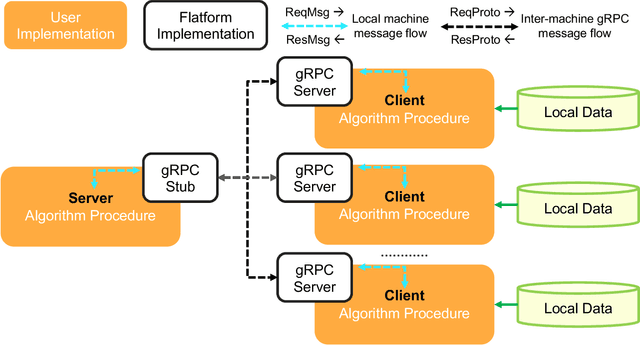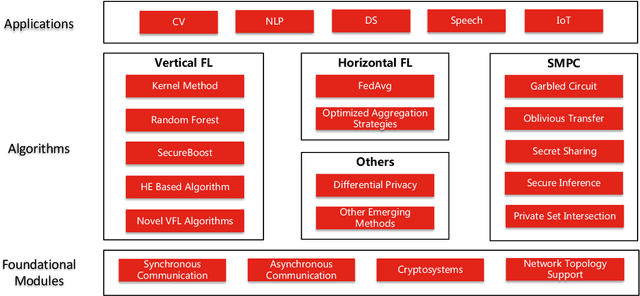Houpu Yao
An Efficient and Robust System for Vertically Federated Random Forest
Jan 26, 2022Abstract:As there is a growing interest in utilizing data across multiple resources to build better machine learning models, many vertically federated learning algorithms have been proposed to preserve the data privacy of the participating organizations. However, the efficiency of existing vertically federated learning algorithms remains to be a big problem, especially when applied to large-scale real-world datasets. In this paper, we present a fast, accurate, scalable and yet robust system for vertically federated random forest. With extensive optimization, we achieved $5\times$ and $83\times$ speed up over the SOTA SecureBoost model \cite{cheng2019secureboost} for training and serving tasks. Moreover, the proposed system can achieve similar accuracy but with favorable scalability and partition tolerance. Our code has been made public to facilitate the development of the community and the protection of user data privacy.
Fedlearn-Algo: A flexible open-source privacy-preserving machine learning platform
Jul 30, 2021

Abstract:In this paper, we present Fedlearn-Algo, an open-source privacy preserving machine learning platform. We use this platform to demonstrate our research and development results on privacy preserving machine learning algorithms. As the first batch of novel FL algorithm examples, we release vertical federated kernel binary classification model and vertical federated random forest model. They have been tested to be more efficient than existing vertical federated learning models in our practice. Besides the novel FL algorithm examples, we also release a machine communication module. The uniform data transfer interface supports transferring widely used data formats between machines. We will maintain this platform by adding more functional modules and algorithm examples. The code is available at https://github.com/fedlearnAI/fedlearn-algo.
FEA-Net: A Physics-guided Data-driven Model for Efficient Mechanical Response Prediction
Jan 31, 2020



Abstract:An innovative physics-guided learning algorithm for predicting the mechanical response of materials and structures is proposed in this paper. The key concept of the proposed study is based on the fact that physics models are governed by Partial Differential Equation (PDE), and its loading/ response mapping can be solved using Finite Element Analysis (FEA). Based on this, a special type of deep convolutional neural network (DCNN) is proposed that takes advantage of our prior knowledge in physics to build data-driven models whose architectures are of physics meaning. This type of network is named as FEA-Net and is used to solve the mechanical response under external loading. Thus, the identification of a mechanical system parameters and the computation of its responses are treated as the learning and inference of FEA-Net, respectively. Case studies on multi-physics (e.g., coupled mechanical-thermal analysis) and multi-phase problems (e.g., composite materials with random micro-structures) are used to demonstrate and verify the theoretical and computational advantages of the proposed method.
Image Decomposition and Classification through a Generative Model
Feb 09, 2019



Abstract:We demonstrate in this paper that a generative model can be designed to perform classification tasks under challenging settings, including adversarial attacks and input distribution shifts. Specifically, we propose a conditional variational autoencoder that learns both the decomposition of inputs and the distributions of the resulting components. During test, we jointly optimize the latent variables of the generator and the relaxed component labels to find the best match between the given input and the output of the generator. The model demonstrates promising performance at recognizing overlapping components from the multiMNIST dataset, and novel component combinations from a traffic sign dataset. Experiments also show that the proposed model achieves high robustness on MNIST and NORB datasets, in particular for high-strength gradient attacks and non-gradient attacks.
Low-cost Measurement of Industrial Shock Signals via Deep Learning Calibration
Feb 07, 2019



Abstract:Special high-end sensors with expensive hardware are usually needed to measure shock signals with high accuracy. In this paper, we show that cheap low-end sensors calibrated by deep neural networks are also capable to measure high-g shocks accurately. Firstly we perform drop shock tests to collect a dataset of shock signals measured by sensors of different fidelity. Secondly, we propose a novel network to effectively learn both the signal peak and overall shape. The results show that the proposed network is capable to map low-end shock signals to its high-end counterparts with satisfactory accuracy. To the best of our knowledge, this is the first work to apply deep learning techniques to calibrate shock sensors.
Improving Model Robustness with Transformation-Invariant Attacks
Jan 31, 2019



Abstract:Vulnerability of neural networks under adversarial attacks has raised serious concerns and extensive research. Recent studies suggested that model robustness relies on the use of robust features, i.e., features with strong correlation with labels, and that data dimensionality and distribution affect the learning of robust features. On the other hand, experiments showed that human vision, which is robust against adversarial attacks, is invariant to natural input transformations. Drawing on these findings, this paper investigates whether constraints on transformation invariance, including image cropping, rotation, and zooming, will force image classifiers to learn and use robust features and in turn acquire better robustness. Experiments on MNIST and CIFAR10 show that transformation invariance alone has limited effect. Nonetheless, models adversarially trained on cropping-invariant attacks, in particular, can (1) extract more robust features, (2) have significantly better robustness than the state-of-the-art models from adversarial training, and (3) require less training data.
 Add to Chrome
Add to Chrome Add to Firefox
Add to Firefox Add to Edge
Add to Edge